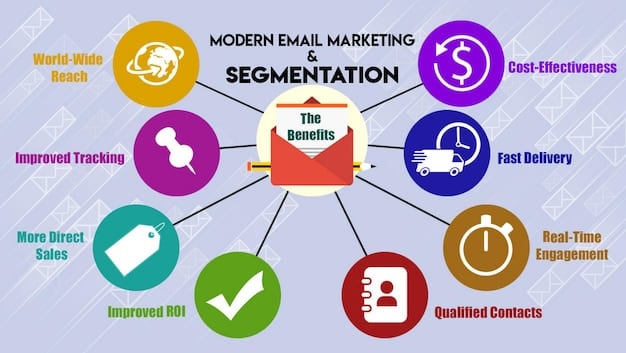Maximize ROI: E-commerce Email Marketing Segmentation Guide for 2025

Maximize ROI: A Data-Driven Guide to E-commerce Email Marketing Segmentation for 2025 delves into advanced strategies for segmenting e-commerce email lists, leveraging data analytics to create targeted campaigns that boost conversions and foster customer loyalty in the ever-evolving digital marketplace.
Are you ready to elevate your e-commerce email marketing game and achieve a significant return on investment? In the dynamic world of online retail, generic email blasts are no longer effective. To truly connect with your customers and maximize ROI: A Data-Driven Guide to E-commerce Email Marketing Segmentation for 2025 is essential.
This guide will provide you with actionable strategies, data-driven insights, and best practices to segment your email lists effectively, personalize your messaging, and drive tangible results. Let’s unlock the power of targeted email marketing and maximize ROI: A Data-Driven Guide to E-commerce Email Marketing Segmentation for 2025.
Understanding the Power of Email Marketing Segmentation
Email marketing remains a cornerstone of successful e-commerce strategies, but its effectiveness hinges on relevance. Segmentation is the key to delivering highly personalized and engaging experiences that resonate with individual customers. By dividing your email list into smaller, more focused groups based on specific criteria, you can tailor your messaging to meet their unique needs and preferences, ultimately boosting engagement and conversions. Understanding emails marketing segmentation is paramount.
Benefits of Email Marketing Segmentation
Segmenting your email list unlocks a multitude of benefits that can significantly impact your e-commerce ROI. Here are some key advantages:
- Increased Engagement: Targeted emails are more likely to capture the attention of recipients, leading to higher open and click-through rates.
- Improved Conversion Rates: By delivering relevant offers and content, you can increase the likelihood of customers making a purchase.
- Reduced Unsubscribe Rates: Personalized messaging minimizes the risk of subscribers feeling bombarded with irrelevant emails, leading to fewer opt-outs.
- Enhanced Customer Loyalty: By demonstrating that you understand their needs, you can foster stronger relationships and build long-term customer loyalty.
Common Segmentation Criteria
Several factors can be used to segment your email list, including:
- Demographics: Segment by age, gender, location, or income level to tailor messaging to specific population groups.
- Purchase History: Target customers based on past purchases, product categories, or spending habits.
- Website Activity: Segment based on browsing behavior, pages visited, or products viewed.
- Email Engagement: Target subscribers who have opened, clicked, or interacted with previous emails.
Understanding these basic segmentation principles is the first step towards email marketing segmentation and improved ROI. Before strategically segmenting, collect various data points to understand your customers.

Data-Driven Strategies for E-commerce Email Marketing in 2025
In 2025, data will be the driving force behind successful e-commerce email marketing segmentation. By harnessing the power of data analytics, you can gain deeper insights into customer behavior and create more effective campaigns.
Leveraging Customer Data Platforms (CDPs)
CDPs are centralized databases that consolidate customer data from various sources, providing a single, unified view of each customer. This comprehensive data enables you to create more accurate and granular segments, leading to highly personalized messaging. The goal is to maximize ROI: A Data-Driven Guide to E-commerce Email Marketing Segmentation for 2025.
Predictive Analytics for Segmentation
Predictive analytics uses statistical techniques to forecast future customer behavior based on historical data. By predicting which customers are most likely to purchase, churn, or engage with your brand, you can proactively tailor your email marketing efforts to meet their needs.
A/B Testing and Optimization
A/B testing involves comparing two versions of an email campaign to determine which performs better. By continuously testing different subject lines, content, and offers, you can optimize your email marketing strategy and maximize your ROI.
Consider all these strategies as you work to maximize ROI: A Data-Driven Guide to E-commerce Email Marketing Segmentation for 2025. It’s crucial to continually optimize your campaigns based on performance metrics.
Advanced Segmentation Techniques for Maximum Impact
Beyond basic segmentation criteria, several advanced techniques can help you to fine-tune your email marketing efforts and achieve even greater results. You can maximize ROI: A Data-Driven Guide to E-commerce Email Marketing Segmentation for 2025 with these strategies.
Behavioral Segmentation
Behavioral segmentation focuses on how customers interact with your website, app, or emails. This includes factors such as pages visited, products viewed, links clicked, and time spent on site.
Lifecycle Segmentation
Lifecycle segmentation involves targeting customers based on their stage in the customer journey, from prospect to loyal advocate. This allows you to deliver the right message to the right customer at the right time. Consider targeting new customers with a welcome email series. You can then segment existing customers based on their purchase and browsing behavior.
- New Customer Onboarding: Welcome new subscribers and introduce them to your brand.
- Abandoned Cart Recovery: Remind customers of items left in their cart and offer incentives to complete the purchase.
- Post-Purchase Engagement: Thank customers for their purchase and provide relevant product recommendations.

Consider developing effective onboarding, abandoned cart and post-purchase strategies.
Personalization and Dynamic Content
Personalization involves tailoring your email content to each individual subscriber based on their unique preferences and characteristics. Dynamic content is a powerful tool for delivering personalized experiences at scale. This technique allows you to automatically adjust email content based on recipient data, ensuring that each subscriber receives a relevant and engaging message.
These strategies will help you to maximize ROI: A Data-Driven Guide to E-commerce Email Marketing Segmentation for 2025. The key in all of this is to continually test and optimize campaigns.
Implementing Your Email Marketing Segmentation Strategy
Developing a successful email marketing segmentation strategy requires careful planning and execution. Here are some key steps to consider:
Define Your Goals and Objectives
Before segmenting your email list, it’s essential to define your goals and objectives. What do you want to achieve with your email marketing efforts? Do you want to increase sales, generate leads, or improve customer engagement? Once you have a clear understanding of your goals, you can develop a segmentation strategy that aligns with your overall business objectives.
Collect and Analyze Customer Data
Data is the foundation of any successful segmentation strategy. Collect as much relevant customer data as possible from various sources, including your website, CRM, social media, and email marketing platform. Analyze this data to identify patterns, trends, and insights that can inform your segmentation decisions. This will allow you to maximize ROI: A Data-Driven Guide to E-commerce Email Marketing Segmentation for 2025.
Choose the Right Segmentation Tools
Many email marketing platforms offer built-in segmentation tools that allow you to easily create and manage your segments. However, depending on your needs, you may want to consider investing in a more advanced CDP or marketing automation platform. Selecting the right tools is essential for effectively implementing and managing your email marketing segmentation strategy.
Monitor and Evaluate Your Results
Regularly monitor and evaluate the results of your email marketing campaigns to identify what’s working and what’s not. Track key metrics such as open rates, click-through rates, conversion rates, and unsubscribe rates. Use this data to refine your segmentation strategy and optimize your campaigns for maximum impact. Through monitoring you can maximize ROI: A Data-Driven Guide to E-commerce Email Marketing Segmentation for 2025.
The Future of E-commerce Email Marketing Segmentation
As technology evolves and customer expectations continue to rise, the future of e-commerce email marketing segmentation will be shaped by several key trends:
Artificial Intelligence (AI) and Machine Learning (ML)
AI and ML will play an increasingly important role in email marketing segmentation, enabling marketers to automate tasks, personalize messaging, and predict customer behavior with greater accuracy. AI-powered segmentation tools can automatically identify and group customers based on various factors, such as demographics, purchase history, website activity, and email engagement.
Hyper-Personalization
Hyper-personalization takes personalization to the next level by delivering highly individualized experiences based on a deep understanding of each customer’s needs, preferences, and context. This involves using real-time data, behavioral insights, and predictive analytics to tailor email content, offers, and timing to each individual subscriber.
Privacy and Data Security
As data privacy becomes an increasingly important concern for consumers, e-commerce businesses will need to prioritize transparency, security, and compliance with data privacy regulations such as GDPR and CCPA. This means being upfront about how you collect, use, and protect customer data, and providing subscribers with control over their personal information. By prioritizing privacy and data security, you can build trust with your customers and foster long-term relationships.
Considering these future trends will help you to maximize ROI: A Data-Driven Guide to E-commerce Email Marketing Segmentation for 2025. Prepare your strategy through ongoing research, testing and implementation.
| Key Point | Brief Description |
|---|---|
| 🎯 Segmentation Benefits | Boost engagement, improve conversions, and reduce unsubscribes. |
| 📊 Data-Driven Insights | Use CDPs, predictive analytics, and A/B testing for optimization. |
| 📧 Personalization | Employ dynamic content and lifecycle segmentation for relevant emails. |
| 🤖 Future Trends | AI, hyper-personalization, and privacy are critical for 2025. |
Frequently Asked Questions
Email marketing segmentation is dividing your email list into targeted groups for personalized campaigns. It’s vital for maximize ROI: A Data-Driven Guide to E-commerce Email Marketing Segmentation for 2025 by improving engagement and conversions through relevant messaging.
Common segmentation criteria include demographics, purchase history, website activity, and email engagement. These factors help tailor your messaging to meet specific customer needs and preferences.
Data analytics provides insights into customer behavior, preferences, and trends, helping to create accurate and granular segments. This personalization helps to maximize ROI: A Data-Driven Guide to E-commerce Email Marketing Segmentation for 2025 by delivering highly targeted and engaging campaigns.
Advanced techniques include behavioral segmentation, lifecycle segmentation, and personalization with dynamic content. These strategies allow for more tailored and relevant messaging, increasing engagement and conversions.
AI will automate tasks, personalize messaging, and predict customer behavior for more accurate segmentation. These advances allow e-commerce businesses to maximize ROI: A Data-Driven Guide to E-commerce Email Marketing Segmentation for 2025 through efficient and effective campaigns.
Conclusion
As you work to implement your e-commerce marketing strategy, use this guide to maximize ROI: A Data-Driven Guide to E-commerce Email Marketing Segmentation for 2025. Segmenting your email marketing campaigns can help boost customer engagement and revenue.
By leveraging data analytics, implementing advanced segmentation techniques, and staying ahead of future trends, e-commerce businesses can unlock the full potential of email marketing and drive significant ROI in 2025 and beyond.





